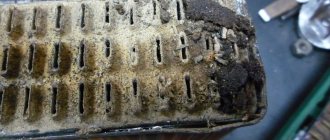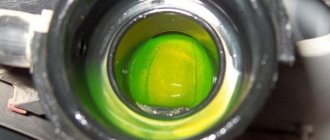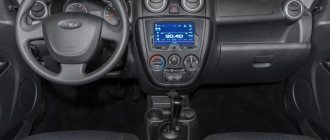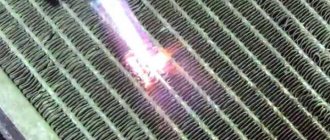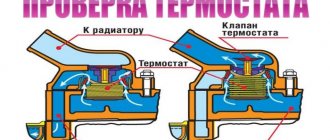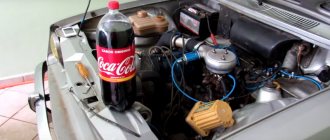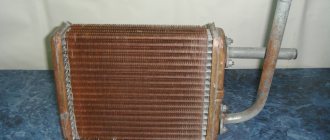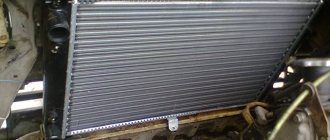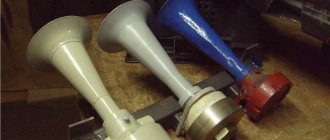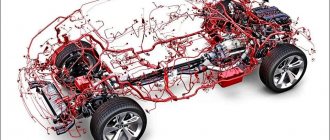Flushing the engine cooling system is an important procedure to prevent engine overheating.
During vehicle operation, the cooling system is subject to a serious load, which can lead to various engine malfunctions. Such engine problems can be prevented by timely and proper radiator maintenance. To do this, it is imperative to regularly flush the cooling system using special auto chemicals, followed by replacing the coolant. In this article we will look at:
- the main causes of clogging of the cooling system,
- how to understand that it’s time to wash,
- how often should you wash?
- what can you wash with?
- How to flush the engine cooling system yourself.
Why do you need to flush the engine cooling system?
The cooling system is an important part of the engine that removes the huge amount of heat generated during engine operation, preventing it from overheating. It is a closed system through which coolant circulates - antifreeze or antifreeze. When the engine is running, the temperature in the cylinders reaches 2000°C, the coolant passing next to the running engine picks up excess heat and removes it.
The cooling system has a rather complex structure. It contains small tubes, pipes, and many channels in which contaminants accumulate. Often they cannot be removed by simply changing the coolant, so flushing is necessary.
Over time, oil and salt deposits, rust, and scale may appear in the cooling system, which settle on the inside of the pipes, in the small channels of the engine and on the radiator itself. All this negatively affects the cooling efficiency of the machine.
As a result, the engine runs at elevated temperatures, problems arise with the oil seals and the entire valve group, and as a result, such an engine becomes completely coked, after which it will have to be spent on a major engine overhaul.
Washing with dismantling
Complete dismantling of the heat exchanger is a troublesome and time-consuming task, but this method makes it possible to clean it not only from the inside, but also from the outside. This method is also better because it can be diagnosed in case of leaks, which can be eliminated by argon welding.
If you still decide to dismantle it, then to gain access to the stove you will have to unscrew the dashboard.
This disassembly is similar to what is required to remove the evaporator when cleaning the air conditioner.
After removing the torpedo you need to:
- Disconnect the pipes leading to the heating unit. In some brands of cars, the heating unit contains an evaporator of the air conditioning system, which means that in order to dismantle the stove, these pipes will also have to be disconnected.
- Carefully unscrew the heating unit and remove it from the interior.
Flushing the stove radiator in this way is made several times easier, because it can be done at home, under hot running water. And even if the chemical ingredients do not help, you can solder the heat exchanger and clean it manually using a brush or similar improvised means in the form of a drill with a long drill bit.
Causes of contamination of the engine cooling system
Antifreeze or antifreeze is used as a coolant in modern cars. These are concentrated solutions that boil away over time and deposits form on the walls of the cooling system.
When the coolant boils away, add distilled water to the system. If you add ordinary tap water instead, it will lead to the deposition of salts on the internal walls of the system. Over time, dust and engine oil also enter the cooling system, all of which also clog the system.
The cooling system becomes dirty when:
- clogging of the cooling system with antifreeze or antifreeze wear products;
- clogging of the external surfaces of the radiator;
- failure of the thermostat, pump, pressure regulating valve, loss of tightness;
- ingress of gas exhaust from the combustion chamber.
If you frequently change the original coolant, flushing the cooling system may not be necessary.
Signs of a clogged radiator
On warm sunny days, the stove is not required. Winter is another matter; during such periods, the system not only helps create a comfortable microclimate in the car, but also performs the functions of blowing the windshield inside the car. If the air inside the car begins to heat up more slowly than usual, the reason should be looked for in the following: a clogged radiator, problems with the thermostat or liquid pump, engine, ventilation system fan, heater leak.
The most common faults:
- The air entering the car is not warm enough - the cooling system is airy. An air lock prevents the flow of warm air into the car interior. Air can enter the system in the following cases: failure of the tightness of the connections or expansion tank plug, when replacing the coolant, wear of the water pump seal;
- cold air begins to flow from the deflectors - the main channels are clogged, as a result, antifreeze does not circulate well through the system;
- lack of air supply - when defects appear in the block (cracks, holes), liquid begins to flow out;
- reduction of heat transfer from the heating radiator due to contaminated honeycombs.
How to know when it's time to clean your cooling system
If you flush the cooling system periodically, you don’t have to worry about its condition. What signs should you look for to know it's time to clean your cooling system?
- Frequent sudden increase in engine temperature, leading to overheating.
- Pump malfunctions.
- When the engine is warm, cold air comes out of the heater.
- Constantly increased fan operation.
These signs should raise concern that the engine cooling system is not working as it should.
Cleaning the air conditioner radiator (condenser)
The condenser in a car is almost always installed in front of the main cooling radiator, so it first of all “gets” all the dirt from the road. Sometimes the condenser becomes so clogged that it is impossible to rinse and clean it with conventional means.
A clogged condenser not only causes poor air conditioning performance, but also causes the engine to overheat. What could be the connection between the cooling system and the air conditioner? It's simple - a completely clogged air conditioner radiator does not allow air flow to the RO, and therefore the main radiator does not cool completely. As a result, the motor itself overheats.
There is no need to remove the condenser again - after cleaning you will have to refill it with freon, so cleaning is usually done while inside the car. Liqui Moly is considered the best product on the market for cleaning air conditioners, but the whole problem is washing off the dirt. Water cannot be supplied under high pressure, as the condenser honeycombs will be crushed, but there is still a way out - you can use a garden sprayer with a capacity of 5-9 liters.
We proceed as follows:
- spray the product from the bottle onto the condenser;
- wait 4-5 minutes;
- rinse the radiator with water from a sprayer;
- We perform the operation several times until the condenser is more or less normally cleaned of dirt.
It is unlikely that you will be able to completely wash the radiator of the air conditioner, but such cleaning will be enough for the normal functioning of the system, and most importantly, the engine will stop overheating with the air conditioner on.
Many motorists experience overheating of a car engine, especially in the summer months of the year. This phenomenon is unsafe, as it can lead to more serious malfunctions that require expensive repairs.
The most common reason for an increase in engine temperature is problems with the cooling system and, in particular, a clogged radiator. In many cases, external cleaning of this unit from contamination will be sufficient. To do this, you need to be able to distinguish the symptoms of radiator malfunctions, as well as what cleaning agents to clean.
How often should you wash?
Flushing the engine cooling system can be internal or external. External treatment consists of flushing the outside of the radiator to remove dirt, dust, and insects. Internal treatment allows you to flush the system from the inside.
Recommendations for the frequency of internal flushing of the cooling system:
- The cooling system should be thoroughly flushed when changing antifreeze or antifreeze. In this case, flushing helps remove the remaining old technical fluid, since it is better not to mix different antifreezes.
- Also, flushing should be carried out for preventive purposes. Carry out washing once a year, it is better to do this in the spring season. Such manipulation will help solve many problems caused by clogged pipes, deterioration of their throughput and heat transfer.
- If symptoms appear that indicate the need for flushing, it should be carried out immediately before more significant damage occurs.
What to choose: home remedies or specialized ones
For washing, you can use both specialized and home remedies. Improvised solutions were mainly used earlier, when there were few specialized automotive chemicals on sale. Now that the choice of means for flushing the cooling system is quite large, few people use home remedies. But they are very effective, inexpensive and always at hand. Therefore, they will always have their supporters.
But still, store-bought ready-made liquids are the best solution. Such substances have the necessary composition that will reliably remove all unnecessary deposits without having a negative effect on car parts.
What you need to know before flushing the engine cooling system
The engine cooling system has a complex structure and includes parts made of different materials: plastic, rubber, various metals, including cast iron, steel and aluminum. All these parts have different resistance to chemical reagents, for example, aluminum is poorly resistant to chlorine and caustic soda. Therefore, before you start flushing the engine cooling system, you should carefully study the composition of the product that is supposed to be used to clean the system so that the product does not destroy its components.
Also, during aggressive flushing of the system, thin channels can become clogged with pieces of rust, scale, and pieces of film of evaporated antifreeze, which can lead to complete blockage of the channels and overheating of the engine in the future. Therefore, it is advisable to fill only with the original coolant recommended by the manufacturer, replace it on time and periodically flush the cooling system so that global problems do not arise later.
Can flushing products damage the system?
Improper use of cooling system cleaning products can cause great harm to your vehicle. To avoid this, you cannot use two or more specialized tools at once. You only need to flush the system with one product. Most solutions are sold in the form of concentrates; they must be diluted, since highly concentrated solutions can destroy rubber and plastic parts, especially acidic preparations.
Flushing the engine cooling system yourself
First, you need to prepare the working fluid; for this you can purchase additives and auto chemicals that are designed specifically for flushing the radiator, or limit yourself to available home remedies. It is not worth using ordinary distilled water for this, since it only cleans the sediment, while dense deposits and calcium deposits remain. Regardless of what means you use to flush the engine cooling system, the sequence of actions is almost the same.
Step-by-step instructions for flushing the cooling system yourself
- wait until the engine cools down . Flushing and changing the coolant is done on a cold car, so you need to wait until the engine cools down, which will protect it from thermal deformation as a result of significant temperature fluctuations. Pouring cold wash solution and cold antifreeze into a hot engine can cause the engine cylinder head to crack or the valve cover to move, which will require expensive repairs. Therefore, you should never rush when performing such maintenance.
- Drain the used antifreeze . At the same time, you should pay attention to its transparency: if it is cloudy, it requires repeated cleaning. Draining the coolant is a simple process. You should unscrew the radiator caps and drain the old antifreeze, then unscrew the cap in the expansion tank. Afterwards, you need to drain the antifreeze from the engine, for which you find a drain plug on the crankcase and unscrew it, wait until the liquid drains completely.
- Pour cleaner into the radiator. All pipes and plugs are screwed back in, after which the required volume of flushing fluid is poured into the radiator.
- Leave the car idling for 20-30 minutes. The engine starts and warms up to operating temperature. This will allow the cleaning solution to circulate through the system, flushing out any deposits. The instructions for a specific product contain information on the operating time of the engine to completely clean the system of contaminants.
- Turn off the car engine and wait for it to cool for 2 hours . After completing the flushing, you need to turn off the engine, let it cool for at least 30 minutes, then pour the fluid out of the engine and add new antifreeze. In some cases, it is necessary to bleed the system by pressing on the pipes to expel air bubbles from the system.
- Discard the cleaning solution . The procedure is repeated as when draining used coolant.
- Assess the condition of the liquid: if it has changed significantly, you need to repeat the procedure.
How to avoid radiator contamination
It will not be possible to completely isolate the radiator from dirt. All a car enthusiast can do is to ensure that the radiator does not become clogged for as long as possible. This can be achieved in the following ways:
- Use only high-quality antifreeze recommended by the car manufacturer. The brand and type of coolant can be found in the machine's operating instructions. And you can purchase such antifreeze at specialized service centers that have the appropriate certificates;
- Carry a supply of distilled water with you. When the driver discovers that there is no antifreeze, he usually fills the radiator with whatever he can get his hands on. This is usually water from a river or stream. The amount of scale that forms in the radiator after such water is enormous. Therefore, you should always have distilled water on hand. It will allow you to get to the garage and extend the life of the radiator.
Keeping a supply of distilled water in the trunk will help avoid radiator clogging
So, anyone who wants their car to run properly must keep the radiator clean. No special skills are required to wash it. All you need is an open-end wrench and a suitable detergent.
Cooling system flushing products
To flush the engine cooling system yourself, you can use the following available products as a cleaning agent.
Distilled water
Pour it into the radiator. Start the car and let it idle for about 15-20 minutes. Turn off the engine and drain the water from the cooling system. This manipulation must be repeated many times until the water becomes clear.
Lemon acid
Diluted in water, it perfectly removes scale, rust and dirt. For prevention, you need to dissolve 40 g in 1 liter of water. For more complex cases, you need to increase the concentration to 100 g, pour the composition into the radiator and warm up the engine. Leave overnight and drain the liquid. The manipulation can be repeated.
Acetic acid
To make a cleaning solution, you need to take half a liter of 70% vinegar per bucket (10 liters) of distilled water. Drain the coolant and add the prepared solution. Then the car is warmed up for 20 minutes. Next, leave the flushing liquid inside the system overnight.
Fanta
It contains citric acid, which is why it is used when flushing the cooling system. You need to pour soda into the cooling system instead of antifreeze and let the car sit with the engine running for 30-40 minutes.
Lactic acid or whey
Lactic acid is more effective, but whey is more affordable. Sequence of serum use:
- prepare about 10 liters of whey;
- strain the entire prepared volume repeatedly through cheesecloth;
- pour the serum into the radiator and leave the car with the engine running for a while;
- drain the whey while hot;
- wait until the engine cools down, fill with boiled or distilled water;
- turn on the engine again, wait half an hour, drain the water;
- wait until the engine cools down;
- pour in the antifreeze that will be used;
- pump air out of the system.
Caustic soda
Caustic soda is sodium hydroxide, which is very alkaline. Caustic soda can only be used to clean copper radiators, but cannot be used with aluminum parts, as it corrodes the aluminum. The copper radiator will have to be dismantled before washing with caustic soda. And after processing, put it back in place.
According to the instructions of the plant for the production of copper radiators, flushing the cooling system is done as follows:
- remove the radiator from the car.
- Rinse its insides with ordinary water, blow with compressed air (without increasing the pressure of 1 kgf/cm2) until clear water flows out of the radiator.
- Prepare approximately 1 liter of 10% caustic soda solution.
- Heat the solution to at least +90°C.
- Pour the solution into the radiator.
- Wait half an hour.
- Drain the solution.
- For 30 minutes, flush the insides of the radiator with hot water, alternating with blowing hot air (pressure should be below 1 kgf/cm2) in the direction of the opposite direction of pump operation.
Lemon acid
One popular technique is cleaning with citric acid. The accessibility of the method is ensured by the low cost of bags of granules. The optimal concentration is considered to be a solution prepared from 10 liters. water, pre-boiled and 200 g of granules.
When the substance is completely dissolved, the portion can be poured directly into the system through the expansion tank. It is important not to exceed the permissible fluid level. In order for a chemical reaction to occur, it is advisable to bring the engine to operating temperature and drive several kilometers on this composition.
During this process of flushing the cooling channels and radiator, it is necessary to monitor the temperature. The maximum effect is achieved at values close to 800C. After flushing with an acidic liquid, it is necessary to drain it and clean it with distilled water, and only then fill the system with antifreeze.
What is the best way to avoid flushing the cooling system?
Household cleaning products are mainly designed to eliminate organic contaminants; most of them will not be able to wash out machine oil. Therefore, you should not waste time and use tools that are not designed for this.
The following products should not be used to flush the radiator.
- Coca-Cola. In principle, you can flush the cooling system with Coca-Cola, but there are several nuances that you should know. It contains orthophosphoric acid, which is the main active ingredient when flushing; it is able to remove scale, rust, and oil residues from the cooling system. But with prolonged exposure, phosphoric acid can damage aluminum, plastic and rubber parts of the system. Therefore, the duration of treatment with Coca-Cola should not exceed 10 minutes. Cola also contains a large amount of sugar and carbon dioxide, which also damage the cooling system. To eliminate these negative aspects, you need to keep the Cola open so that carbon dioxide evaporates, and after treating with Cola, rinse the cooling system with distilled water to remove any remaining sugar.
- Fairy. Any household grease remover like Fairy will not be able to remove all deposits in the cooling system, since such compounds are designed to combat grease, not engine oil. In order for Fairy to clean something at least a little, you need to fill it several times, start the engine and warm it up, drain it and fill it with a new one. A lot of fuss, but little use.
- Calgon . Compositions such as Calgona are designed to remove only limescale; they cannot cope with other contaminants. Therefore, there is no point in using them to flush the engine cooling system.
- Whiteness . The main active ingredient in Whiteness is sodium hypochlorite, which corrodes aluminum. Any chlorine-based solutions cannot be used to flush the cooling system.
- Mole . Mole-type solutions containing caustic soda corrode rubber seals, seals and gaskets.
Using soda
In search of something that can quickly clean the radiator of your car, car owners come across the option of using soda. Washing is carried out using both caustic soda (caustic soda) and other alkaline preparations.
It is enough to use this technique once every two years or after every 30-40 thousand kilometers. It is worth paying attention to the concentration of the composition for different alkaline preparations:
- for caustic soda, the composition should not exceed 3%;
- soda ash is usually increased to 7-10%;
- baking soda is also diluted to 10%.
Both distilled and boiled water are used as the main liquid. It is advisable to travel several tens of kilometers with such trains. To avoid a chemical reaction with aluminum or copper that is part of the radiator and stove, it is not recommended to keep such a solution in the system for more than a day.
Specialized products for flushing the cooling system
To flush the cooling system, you can purchase specialized products designed specifically for this purpose.
Such means are:
- neutral : they do not contain aggressive components, so large and old deposits are cleaned with less efficiency. Such remedies are suitable for prevention.
- Alkaline : they contain alkalis that perfectly remove organic contaminants.
- Acidic : They contain an acid that quickly and effectively breaks down inorganic deposits.
- Two-component mixtures (universal): they consist of alkalis and acids.
Cleaning the external elements of the radiator
The best option is to flush the radiator with water under pressure. This can be done either in your garage (if you have a suitable compressor) or at the nearest car wash.
The best option for external radiator cleaning is flushing with water under pressure.
This cleaning method perfectly removes even the smallest contaminants, such as poplar fluff that has accumulated between the fins of the radiator. But you need to remember the following:
- the water pressure should not be too strong, since the radiator fins are very thin and easily deformed;
- There should be no aggressive chemical additives in the water. Rubber hoses with clamps and gaskets are attached to the radiator. Aggressive detergents can corrode all this, and the cooling system will lose its seal.
How to choose a specialized cleaning agent
To select a specialized cleaning agent, consider the following:
- Find out what contaminants predominate in the car's cooling system. Conventionally, they can be divided into 2 types: inorganic (scale, rust and metal oxides) and organic (decomposition products of antifreeze). The presence of the first type of contaminants in the system is evidenced by a rusty-white coating under the radiator cap or expansion tank. The presence of organic contaminants is indicated by darkened antifreeze or antifreeze.
- Acid-based cleaning products are suitable for removing rust and scale. They contain phosphates. Alkaline-based products effectively remove dirt, oil and antifreeze decomposition products. They contain surfactants and pH regulators. There are few universal cooling system cleaners because acidic components do not get along with alkaline ones. Such drugs generally work ineffectively, because... they contain a small proportion of active components.
- The preparations must contain complexing additives that help quickly dissolve sediment and easily remove dirt from the system. It’s great when the product also contains corrosion inhibitors that protect metal elements from destruction. If flushing the cooling system is water-based, the description should indicate that this water is deionized, i.e. does not contain salts, which allow scale formation.
- It is worth paying attention to the cost of the product. A very low cost compared to other drugs may indicate that the drug contains few active ingredients.
- The size of the package also matters: the optimal capacity is 300-450 ml. You also need to take into account the density of the liquid. The higher it is, the higher the concentration of active components in the drug. Therefore, with the same package volume, you need to choose the drug that is heavier.
- Read the instructions for using the product. The first thing that should be suspicious is that the cleaning time is too short. It will not be possible to perfectly and reliably flush the cooling system in 2-5 minutes - either the product does not work well, or it is too aggressive and can damage the parts. After using the cleaner, the cooling system must be flushed with water to remove traces of contamination.
- The consistency and properties of the cleaner are the main indicator. If sediment forms in the bottle at room temperature, it may also form in the cooling system.
- The product should not produce foam. It can cause the engine to overheat during cleaning and will also interfere with changing the coolant.
The car's cooling system should be flushed as a preventive measure, and not as a forced solution to solve the problem. You need to flush every time you replace antifreeze or antifreeze, and the temperature of the car engine will always be fine.
Auto parts and service stations
External radiator flushingIf the engine can be compared to the heart of a car, then the cooling system is, perhaps, the endocrine glands. The normal functioning of the cooling system is vital for the car, because failure to diagnose it in a timely manner or replace the necessary elements can result in serious problems with the engine. Based on this, for the normal operation of the cooling system, all you need is proper care and regular maintenance.
The radiator, as its main component, which takes on the main impact of dirt and dust, especially needs timely washing and cleaning. Sand, dirt, rust and scale, the corpses of careless insects - all this accumulates in abundance in the radiator, located directly in front of the car engine.
If your faithful iron horse makes it clear that its cooling system is malfunctioning and the radiator is clogged, then you can follow 2 existing ways to solve this problem:
- go to the store and buy a new radiator.
- Rinse and clean the radiator yourself.
It is not difficult to tidy up the engine cooling system yourself. The main thing before cleaning is to follow all safety rules: be sure to let the engine cool, firmly secure the hood, and wear waterproof gloves.
To check for contamination of the radiator, you need to drain all the antifreeze from it (if the liquid is clean, then there is no need to flush the radiator - there is no scale or rust in it) and pour clean water (preferably distilled) into the cooling system. Next, you need to start the car and let it run for 15-20 minutes, and then drain the water. This operation is carried out several times until clean water comes out of the drain taps. To enhance the efficiency of the operation, add a radiator cleaning agent (or caustic soda, or anti-scale agent) to the water. To do this, you don’t need a lot of special radiator flushing agent - just a few grams will be enough. Try not to overuse the amount of product, and follow the instructions on the packaging of the cleaning product - if the dosage is incorrect, you can damage the cooling system.
After flushing the radiator is completed, drain the water and the cleaning agent and rinse the radiator with clean water at least 5 times. Failure to properly remove any remaining radiator cleaner can lead to corrosion in the radiator. In order to prevent scale formation, various additives are added to antifreeze, which is based on ethylene glycol, which, thanks to their anti-corrosion and lubricating elements, prevent the formation of rust and various deposits in the radiator.
Very often, the result of overheating of a car engine is a radiator clogged on the outside (for example, with dust or poplar fluff). To solve this problem, the radiator is usually purged. For this radiator cleaning process, you can remove it and wash it on the floor using standard mini-washers or a jet of water under pressure. Try not to overdo it with pressure, as this can damage the radiator honeycomb. When flushing the radiator, it is undesirable to use chemical liquids based on aggressive acidic components. This can cause significant damage to the entire cooling system, radiator seals and hoses.
The final stage in cleaning and flushing the radiator is filling it with new coolant and pumping out any excess air that could have formed when it was filled. To do this, open the radiator cap and start the engine for a few minutes. After the cooling system starts operating, the air pockets will come out on their own; all you have to do is add a little antifreeze into the resulting free space and close the lid.
Source: Drive2.ru.
There are two reasons for internal pollution:
- dirt enters the cooling system from the outside. If there are cracks in the radiator hoses or in the radiator itself and the tightness of the system is broken, then its clogging is only a matter of time;
- The radiator becomes dirty due to poor antifreeze. It's no secret that finding high-quality antifreeze today is not so easy. The market is literally flooded with fakes. Antifreeze from well-known brands is especially often counterfeited.
Both dirty and fake antifreeze contain many foreign impurities. The radiator becomes very hot during operation. Sometimes antifreeze can even boil, and the impurities it contains form scale, which impedes the circulation of the coolant. Which leads to overheating of the motor.
WHEN SHOULD YOU FLUSH THE RADIATOR
Here are the signs that the cooling system is clogged:
- the engine quickly overheats even in the cold season, after which power failures appear, which are especially noticeable when trying to accelerate;
- The “coolant” light is constantly on on the dashboard, although there is antifreeze. This is another typical sign of a clogged radiator.
To avoid the above problems, car manufacturers recommend flushing cooling systems at least once every 2 years.
DIFFERENT WAYS TO WASH THE RADIATOR WITHOUT REMOVING IT
You can flush the radiator with various liquids. And the only tool the car owner will need is an open-end wrench to unscrew the drain plug in the cooling system. The washing sequence itself differs only in the type of liquid used and consists of the following steps:
- The car engine starts, idles for 10 minutes, then turns off and allows to cool for 20 minutes.
- The drain plug is unscrewed. The old antifreeze is drained. In its place, flushing liquid is poured.
- The engine starts again and runs for 10–15 minutes.
- After the engine has cooled, the liquid is drained. Distilled water is poured in its place to remove any remaining detergent from the radiator.
- New antifreeze is poured into the system.
WASHING WITH SPECIAL MEANS
In any auto parts store you can find special compounds for flushing automobile cooling systems. There are many of them, but the most popular among car enthusiasts are two liquids: LAVR and Motorresurs.
They have an optimal price-quality ratio.
WASHING WITH CITRIC ACID
Acid dissolves scale well. To create an acidic environment in the radiator, drivers successfully use a solution of citric acid in water.
Here are the main features of the process:
- the solution is prepared in the proportion of 1 kilogram of acid per 10-liter bucket of water. If the radiator is not too clogged, the acid content can be reduced to 700 grams;
- flushing is carried out according to the scheme given above, with the exception of one important point: the hot acid solution is not drained from the system immediately, but after about an hour. This allows you to achieve the best effect.
VIDEO: WASHING THE RADIATOR WITH CITRIC ACID
ABOUT RINSE WITH DISTILLED WATER
Distilled water is very rarely used as a standalone detergent.
This is done only when the radiator is slightly dirty. The reason is simple: water does not dissolve scale. It only flushes out the debris and dirt that has accumulated in the radiator. It is for this reason that distilled water is usually used only for flushing the radiator after the main detergent.
RINSE WITH COCA-COLA
Coca-Cola has many unusual uses. These include flushing the radiator.
Once in the cooling system and warmed up, the drink quickly dissolves even a very thick layer of scale. But there are two important points:
- The operating time of the motor when washing should be no more than 3 minutes. Then the engine is turned off, and the drink is drained from the system only after half an hour;
- It is necessary to rinse the system with water after Coca-Cola very carefully. The drink contains a lot of sugar. And it can settle on the radiator pipes.
WHAT NOT TO WASH THE RADIATOR
Here's what it's not recommended to put in the radiator:
- tap water. It contains many impurities and inorganic salts. When such water boils, even more scale forms in the radiator;
- acetic acid solution. Acetic acid is good for cleaning electric kettles, but it is better not to pour it into the radiator. It will not only dissolve scale, but also corrode the radiator pipes.
Source: bumper.guru
